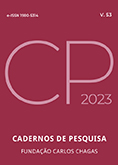Women make up the majority of the players, but they don’t program
Keywords:
Women, Job Market, Technology, Digital GamesAbstract
In Brazil, women make up the majority of digital game players, but they are not highly represented in the industry’s development and programming workforce, a fact that is common to other STEM careers. Considering this contradiction, a qualitative study with 22 women who work in this market as programmers sought to identify the barriers to increasing female representation in game development in the country. The results show that there are six types of barriers that begin as soon as the course is chosen and persist more intensely in the job market, and the main one is the lack of credibility in terms of technical knowledge.
Downloads
References
Accenture. (2021). Gaming: The next super plataform. https://www.accenture.com/us-en/insights/software-platforms/gaming-the-next-super-platform
Bacelar, A. S., Campos, A. C., Santos, L. T., Nascimento, T. B. P. do, & Rezende, D. C. de. (2021). Gênero e construcionismo social: Os desafios das mulheres na tecnologia da informação. Revista de Administração IMED, 11(1), 1-23. https://doi.org/10.18256/2237-7956.2021.v11i1.4364
Bardin, L. (2011). Análise de conteúdo. Edições 70.
Bristot, P. C., Pozzebon, E., & Frigo, L. B. (2017). A representatividade das mulheres nos games. In Proceedings of XVI SBGames (pp. 862-871). Sociedade Brasileira de Computação.
CNN Business (2022). Brasil tem mais smartphones que habitantes, aponta FGV. CNN Brasil. https://www.cnnbrasil.com.br/economia/brasil-tem-mais-smartphones-que-habitantes-aponta-fgv/
Fernandes, A. (2021). Mulheres são só 26% em profissões tecnológicas. Valor Investe. https://valorinveste.globo.com/mercados/brasil-e-politica/noticia/2021/09/10/mulheres-sao-so-26percent-em-profissoes-tecnologicas.ghtml
Follador, S. R. (2021). {reprograma}: Gênero e tecnologia em um estudo de caso preliminar. Revista Estudos Feministas, 29(1), Artigo e67314. https://doi.org/10.1590/1806-9584-2021v29n167314
Forbes. (2020, September). 20-First’s gender balance scorecard. Top 14 global gaming companies. Please wait... Gender balance loading. https://20-first.com/wp-content/uploads/2020/08/200825-2020-Global-Gaming-Scorecard-Web.pdf
Fortim, I. (Org.). (2022). Pesquisa da indústria brasileira de games. Abragames.
Giovannetti, V. E. G. (2023). Elas são maioria do volume de jogadores, mas não programam: Por trás da baixa representatividade das mulheres na programação de jogos digitais no Brasil [Dissertação de Mestrado Profissional MPGC, Fundação Getulio Vargas]. Biblioteca Digital FGV. https://bibliotecadigital.fgv.br/dspace/handle/10438/33549
Instituto Brasileiro de Geografia e Estatística (IBGE). (2021). Estatísticas de gênero: Indicadores sociais das mulheres no Brasil. IBGE.
Lombardi, M. R. (2018). Carreiras femininas nas engenharias: Barreiras intransponíveis? In J. A. de Oliveira, & M. Matsuo (Orgs.), Condições de trabalho das mulheres no Brasil (pp. 27-37). Fundacentro. https://www.researchgate.net/publication/330369807_Condicoes_de_Trabalho_das_Mulheres_no_Brasil_-_II_Seminario_de_Sociologia_da_Fundacentro
Machado, C. (2022, 26 abril). Mulheres em Stem: É emblemática a baixa adesão das mulheres às carreiras de alto retorno. Folha de S.Paulo, A24.
McCullough, L. (2011). Women’s leadership in Science, Technology, Engineering and Mathematics: Barriers to participation. Forum on Public Policy Online, 2011(2).
Na prática. (2022). Síndrome do impostor: O que é e como pode atrapalhar profissionais a se desenvolverem na carreira. https://napratica.org.br/o-que-e-sindrome-do-impostor/
Newzoo. (2022a). Global games market report.
Newzoo. (2022b). Key insight into Brazilian gamers. https://newzoo.com/resources/trend-reports/key-insights-into-brazilian-gamers-newzoo-gamer-insights-report
Oliveira-Silva, L. C., & Parreira, V. A. D. (2022). Barreiras e enfrentamentos de mulheres em carreiras predominantemente masculinas. Revista Estudos Feministas, 30(1), Artigo e74161. https://doi.org/10.1590/1806-9584-2022v30n174161
Page Group. (2021). Women in tech. O que as organizações estão fazendo para quebrar as barreiras? https://www.michaelpage.com.br/estudos-e-tend%C3%AAncias/women-in-tech
Pesquisa Game Brasil (PGB). (2022). Tudo sobre o Perfil Gamer. https://www.pesquisagamebrasil.com.br/pt/
Pires, Y. P., Rego, L., Lima, M. R. A., & Albuquerque, F. A. de, Jr. (2021). Diagnóstico da presença feminina nos cursos superiores e no mercado de trabalho em tecnologia da informação no estado do Pará. In Anais do XII Computer on the Beach (pp. 428-434). Univali.
Resmini, M. (2016). The “Leaky Pipeline”. Chemistry – A European Journal, 22(11), 3533-3534. https://doi.org/10.1002/chem.201600292
Romano, S. M. V., Espíndola, M. G., & Santos, T. N. dos. (2020). A discriminação de gênero na TI e seus impactos na sociedade. Processando o Saber, 12, 146-162. https://fatecpg.edu.br/revista/index.php/ps/article/view/210
Sakuda, L., & Fortim, I. (Orgs.). (2018). II Censo da Indústria Brasileira de Jogos Digitais. Ministério da Cultura.
Santos, C. M. (2018, 7 março). Por que as mulheres “desapareceram” dos cursos de computação? Jornal da USP.
Santos, E. F. dos, Diogo, M. F., & Shucman, L. V. (2014). Entre o não lugar e o protagonismo: Articulações teóricas entre trabalho, gênero e raça. Cadernos de Psicologia Social do Trabalho, 17(1), 17-32. https://doi.org/10.11606/issn.1981-0490.v17i1p17-32
Tockey, D., & Ignatova, M. (2019). Gender Insights Report: How women find jobs differently. LinkedIn Talent Solutions. https://business.linkedin.com/content/dam/me/business/en-us/talent-solutions-lodestone/body/pdf/Gender-Insights-Report.pdf
Published
How to Cite
Issue
Section
License
Copyright (c) 2023 Cadernos de Pesquisa

This work is licensed under a Creative Commons Attribution-NonCommercial 4.0 International License.
Authors who publish in this journal agree to the following terms:
a. Authors retain the copyright and grant the journal the right to first publication, with the paper simultaneously licensed under the Creative Commons Attribution license that allows the sharing of the paper with acknowledgment of authorship and initial publication in this journal.
b. Authors are authorized to assume additional contracts separately, for non-exclusive distribution of the version of the paper published in this journal (for example publishing in institutional repository or as a book chapter), with acknowledgment of authorship and initial publication in this journal.
c. Authors are allowed and encouraged to publish and distribute their paper on-line (for example in institutional repositories or on their personal page) at any moment before or during the editorial process, as this can generate productive changes, as well as increase the impact and citation of the published paper (See The Effect of Open Access).









